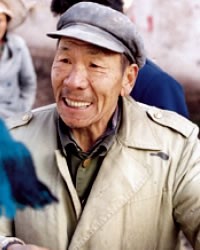Han Chinese, Hokkien in Malaysia

Photo Source:
Asia Harvest-Operation Myanmar
|
Send Joshua Project a map of this people group.
|
| People Name: | Han Chinese, Hokkien |
| Country: | Malaysia |
| 10/40 Window: | Yes |
| Population: | 2,214,000 |
| World Population: | 43,504,500 |
| Primary Language: | Chinese, Min Nan |
| Primary Religion: | Ethnic Religions |
| Christian Adherents: | 12.00 % |
| Evangelicals: | 9.20 % |
| Scripture: | Complete Bible |
| Ministry Resources: | Yes |
| Jesus Film: | Yes |
| Audio Recordings: | Yes |
| People Cluster: | Chinese |
| Affinity Bloc: | East Asian Peoples |
| Progress Level: |
|
Introduction / History
Hokkien is the largest Chinese dialect spoken among Chinese groups in Malaysia. Originally, the Hokkien people were the descendants of the earliest Chinese settlers on the Peninsula who originated mainly from Fujian (also called Min) Province in China. Presently, the majority of Chinese in Malaysia, no matter their ethnic background, use Hokkien as a trade language to converse with other Chinese in particular regions.
However, most Chinese in these particular regions no longer speak a pure form of the various Fujian dialects. Today they speak a Hokkien which contains a number of loanwords from Malay and other Chinese dialect groups.
The Hokkien dialect is the lingua franca for the Chinese in Johor, Malacca, Penang, Kedah, Perlis, Terengganu, Kelantan, and Sarawak. As such, the Hokkien as a trade language is the majority Chinese language in these states.
What Are Their Lives Like?
In the past, the main occupations of the Hokkien were as traders and merchants in the import-export industry and wholesale dealers and grocers. Presently, in the rural or semi-rural areas, Hokkien are tin miners, rubber and oil palm estate laborers, fishermen, livestock breeders, and vegetable farmers. Within the urban centers, they are factory workers, clerks, and professionals, small-time shopkeepers, and businessmen.
As with the other Chinese groups, the Hokkien regard surnames (for them this is the first part of the name) within the family as important in retaining kinship and family identity. Sons take on the first name of the father to perpetuate the family line. In the family, the supreme head is the father, or if the family has several generations living under one roof, the supreme head could also be the grandfather or great-grandfather. On the death of the family head, the wife takes over as a supreme head and she is respected like her departed husband.
What Are Their Beliefs?
Most of these peoples grow up in an environment of idol worship, ancestral worship, and strong teachings of filial piety. Their religion, no different from the other Chinese groups, has a multitude of stories, performances, rituals, customs, beliefs, sacred objects and places, deities, festivals, and folk practices.
The main deity in a Hokkien temple is Fazhugong or Zhanggong shengju. This deity, with unkempt long hair and carrying a sword, originally came from the Yongchun district (of Fujian province, China). A notable sight in Hokkien households is the display of three or more generations of ancestral tablets at the family altar, besides other deities. For the typical Hokkien family, a distinct ritual follows when a death occurs: holes are made in the deceased's pockets to prevent him or her from taking away the family's wealth.
A percentage of the Hokkien in Malaysia are Christians.
What Are Their Needs?
The Hokkien people in Malaysia believe that good education is a stepping stone on the path to success. Yet not many have received formal education beyond secondary level. Formal education and vocational training in a wide variety of skills would be helpful. Pray that these needs will be met and also that He would awaken believers to the needs around them.
Prayer Points
Pray for Min Nan workers, filled with the fruit of the Holy Spirit, to disciple Malay Muslims in the ways of Christ.
Pray for Min Nan speakers to begin a family-based movement to Christ that will bless them abundantly.
Pray for Min Nan speakers to have the spiritual hunger to seek and find Jesus Christ.